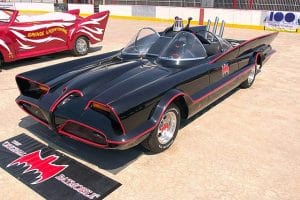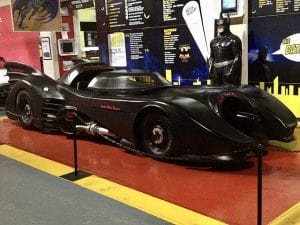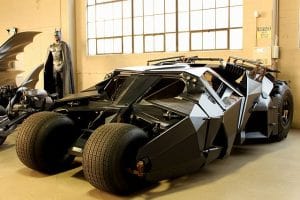For almost as long as there has been a Batman, there has been a Batmobile for him to ride in. But unlike Batman’s iconic suit, the form of the Batmobile is ever-shifting, capable of changing radically in a few short years. Over the years, the Batmobile has taken the form of futuristic bubble cruisers, long-hooded fantastic supercars, hulking military monstrosities, and all-American muscle cars. The cars often reflected the style of visual artists of the time, and also the mindset of the Batman behind the wheel. Was the Batman a virtuous Caped Crusader, a man haunted by crime and urban warfare, or a truly Dark Knight on the edge of violence? Join us as we go back down the road of time and witness the dramatic shifts in the form and function of the Batmobile in Batman’s many screen appearances.
The 60s Classic: Adam West’s Bubble Batmobile
The first Batmobile most audiences remember had a unique and futuristic appearance, but, unlike many of the subsequent Batmobiles, was a fully functional road car. The Batmobile from the 1966 TV series, opens a new window began its life as the Lincoln Futura. Designed for the 1955 auto show circuit, the Futura, opens a new window was emblematic of a time when carmakers spared no expense in promoting extravagant dreams of the future. It offered a long, sleek body, raised fins on the front and rear, and bubble cockpits for the driver and passenger. Parts for the Futura came from Ford’s luxury cars of the 1950s; its chassis was from the Continental Mark II coupe, opens a new window, and its engine the large Lincoln 368 Y-Block V-8, opens a new window. Because it used so many parts from pre-existing cars, the Futura could be used as a road car, unlike many of the show cars produced by other companies, opens a new window. Nearly 10 years after its run on the auto show circuit, its use as a drivable car would become an asset to the first TV series about the Caped Crusader.
Despite being perhaps the most memorable Batmobile of all, the 1966 Batmobile was actually a rush job born of necessity and a speedy production cycle. Designer Dean Jeffries, opens a new window was first tasked with building the Batmobile, and wanted to use a 1959 Cadillac Eldorado, opens a new window as the basis for it. But he had only three weeks to transform the car, which he felt was too short, so he turned the design work over to George Barris, opens a new window. Barris had previously bought the Futura from Ford for $1.00, opens a new window for display purposes, but decided it would be the perfect vehicle to easily modify into a Batmobile. The Futura’s once pearl-white paint was replaced with a glossy black coat, and its front grille was modified to resemble Batman’s cowl, opens a new window, but the car’s overall shape and design was quite recognizable as the Futura’s. The car’s large rear fins would be an influence on numerous Batmobiles, as would the rocket-powered ignition, opens a new window that Barris had added to the Futura.
The 80s Powerhouse: Michael Keaton’s Batmobile
The ‘66 Batmobile remained popular among the public long after the 60’s Batman series ended. By the late 1980s, Warner Bros. knew it needed a radically different design for the Batmobile to make their 1989 movie, opens a new window stand out. The movie’s distinct Art Deco, opens a new window aesthetic, a product of director Tim Burton, drove the designers to come up with a Batmobile that bore little resemblance to any seen before. The basis of this new Batmobile was a chassis from a Chevrolet Impala, opens a new window, and the engine was a large Chevy V-8. Because it used parts from a full-size sedan, this Batmobile was very large-about 20-feet, opens a new window long! The hood of this Batmobile was long, and the cockpit was far back in the car, giving it somewhat of a resemblance to the Stingray, opens a new window Corvettes-or a rocket.
Some of the design elements of this Batmobile would prove just as influential as the ‘66 Batmobile’s introductions were. In interior shots, the Batmobile had a dashboard that resembled a jet fighter’s more than any production car, and future Batmobiles would be strongly influenced by this militarized technology. The Batmobile’s designer, Anton Furst, was strongly influenced by military technology, especially jet aircraft like the F-117 Nighthawk, opens a new window. The Burton-era Batmobile had one more technological trick up its sleeve; a special “Batmissile, opens a new window” mode that destroyed the outer shell, allowing for a speedy escape in a small, bullet-shaped rocket car. This feature was seen in Batman Returns, opens a new window and would prove popular enough to inspire other Batmobiles to have “escape modes” or special vehicles inside. Even with its new technology and radically different appearance, the ‘89 Batmobile retained the two most popular features from its ‘66 predecessor–the large rear fins, and the rocket-powered ignition. It would quickly become an icon in its own right.
The Brutal Tank: The Tumbler, Bale’s Batmobile
The ‘89 Batmobile proved so popular that even once it was replaced, most Batmobile designs all the way up to the early 2000s, opens a new window strongly resembled it. But after the box office disappointment of Batman & Robin, opens a new window in 1997, Warner Bros. decided to go in another distinctly new direction for the series relaunch. 2005’s Batman Begins, opens a new window featured a harder-edged, more realistic take on the Batman mythos, and the Bruce Wayne of this universe needed a military vehicle, not an experimental rocket car or redesigned road car. The Tumbler, opens a new window, the Batmobile designed by Christopher Nolan for the Dark Knight trilogy, was completely custom-made for the movie, sharing little in common with any conventional vehicles of its day.
Explained as a military prototype developed by Wayne Enterprises in Batman Begins, the Tumbler resembled a tank much more than a car. Unlike most Batmobiles before it, the Tumbler lacked fins or an aesthetic link to Batman’s costume; its intimidation comes from its burly proportions, its throaty engine roar, and its many weapons, opens a new window, which include machine guns, a rocket launcher, and mines. The Tumbler did retain one classic Batmobile feature; the rocket engine, now used as an aid in acceleration for jumps. The very first design of the Tumbler was made by director Christopher Nolan himself as a crude model, opens a new window out of Play-Doh while the film was in pre-production; actually designing a road-worthy Batmobile would take nine months, cost several million dollars, and months of practice for the film’s stunt drivers. Though the Tumblers created for the trilogy were actually driveable, opens a new window, the cockpit as shown in the films was a closed set, not the car’s actual dashboard. Despite being driven by Batman in only two movies, opens a new window, the Tumbler Batmobile proved a very popular design with car fans, and replica Tumblers designed by auto enthusiasts are seen as a status symbol by the very, opens a new window wealthy.
The Hot Rod of Vengeance: Pattinson’s Batmobile
The Tumbler was a major design influence on the Batmobile used in Ben Affleck’s appearances, opens a new window as Batman, opens a new window. A proposed solo Batman film to follow up the 2017 Justice League never got past pre-production, and the new Batman movie became independent of the continuity of other DC Comics movies. Batman would now be played by Robert Pattinson, and a new story and Batman also meant a new Batmobile. Surprisingly, this darkest of Dark Knights would drive a Batmobile that resembled a road car once more, finally leaving the exotic experimental and military designs behind.
The Batmobile seen in trailers and promotions for 2022’s The Batman, opens a new window has the look of an aggressive 1970s muscle car. A strong resemblance to the early Mustang, opens a new window and Challenger, opens a new window can be seen in its long hood and angular shape. This Batmobile is deliberately designed to be a “horror car”, a sort of Frankenstein’s monster a young Bruce Wayne stitched together from bits and pieces of old hot rods to assemble into a crime-fighting vehicle. In a first for movie Batmobiles, this car is powered by a rear-mounted engine, a V-8 believed to make 650 horsepower, opens a new window. The car’s rough, opens a new window, almost apocalyptic look fits a Bruce Wayne desperately trying to win his battles with the criminals of Gotham, armed with a beginner’s knowledge but a will to survive and learn. No matter what dangers Batman battles in the future, he’ll always have a Batmobile, and its shape will reflect the distinct form of Gotham–and the shape of Bruce’s soul. You can see the Batmobiles from all of Batman’s movie adventures in CRRL’s collection!




